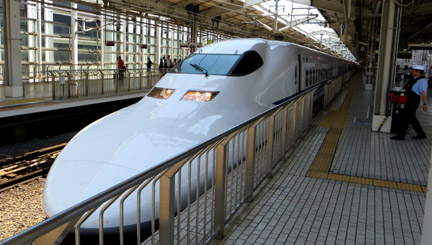 Although California voters recently approved a high speed rail system from San Francisco to Los Angeles, it appears to be slowly unhinging as a result of mounting labor costs as well as the inability to predict how many people will actually use the system. Japan, who produced the first national bullet train system (Shinkansen) is today facing a competitive situation that may be a precursor to similar controversies in California, if that rail system is ever built. Low cost airlines in Japan are eating away at the bullet trains’ profits.
Although California voters recently approved a high speed rail system from San Francisco to Los Angeles, it appears to be slowly unhinging as a result of mounting labor costs as well as the inability to predict how many people will actually use the system. Japan, who produced the first national bullet train system (Shinkansen) is today facing a competitive situation that may be a precursor to similar controversies in California, if that rail system is ever built. Low cost airlines in Japan are eating away at the bullet trains’ profits.
 Three new low-cost airlines, Peach, JetStar Japan, and AirAsia Japan are all flying domestic routes that somewhat parallel those of the bullet trains. As a result, two of the companies offering high speed train service have dropped their prices by more than 30 percent. We here at WoWasis took the Shinjuku/Tokyo to Kyoto route recently, and paid 13,520 yen, or roughly $135 USD. Low cost air carriers are flying the Tokyo to Kyoto route for far less, although the rub is getting to the airport in Tokyo and taking the time to go through airport security. If one is close to a train station in Tokyo, there could be a significant time savings in reaching the destination, although Shinkansen would cost more.
Three new low-cost airlines, Peach, JetStar Japan, and AirAsia Japan are all flying domestic routes that somewhat parallel those of the bullet trains. As a result, two of the companies offering high speed train service have dropped their prices by more than 30 percent. We here at WoWasis took the Shinjuku/Tokyo to Kyoto route recently, and paid 13,520 yen, or roughly $135 USD. Low cost air carriers are flying the Tokyo to Kyoto route for far less, although the rub is getting to the airport in Tokyo and taking the time to go through airport security. If one is close to a train station in Tokyo, there could be a significant time savings in reaching the destination, although Shinkansen would cost more.
Which brings us back to California. The original $50 billion cost estimate to build the California line was a pipedream. Labor costs have soared, lawsuits from property owners disputing the right-of-way are cropping up, and potential riders are questioning what the fare structure will be, just to name several of the obstacles.
Unknown variables include the time it takes to get to an airport and go through security, as opposed to jumping on a train at a station. Every community’s answers to these questions will be different. Japan’s system was established in 1964, before low-cost air was dreamed of. The competitive situation that Shinkansen, the innovator in high speed intercity rail, is facing should be studied by Californians on both sides of the rail controversy. It wouldn’t hurt to work up some real numbers scenarios that might be critical in determining if such a rail system could ever pay for itself.
Leave a Reply